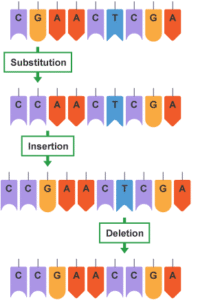Back to: MICROBIOLOGY 200 LEVEL
Welcome to class!
My brilliant friend, welcome back! You’ve been on a roll, and it’s always such a joy to learn together. Today, we’re looking at something very fascinating and important — Types of Mutations: Point, Insertion, and Deletion. These might sound serious, but don’t worry — we’ll make it as clear and familiar as possible, just like explaining a Nollywood story to a friend. Let’s go!
Types Of Mutations: Point, Insertion, Deletion
Imagine you’re reading a recipe to cook party jollof rice. Now, what if one word was misspelt, one ingredient was added twice, or a line was missing entirely? That recipe would turn out confusing, right? The same thing happens when a cell’s genetic “recipe” gets altered — this is what we call a mutation.

A mutation is a change in the DNA sequence. Sometimes it’s small, like changing one letter in a word, and sometimes it’s big, like deleting an entire sentence from a paragraph. These changes can affect how proteins are made in the body and how cells function.
Point Mutation
A point mutation happens when one single base in the DNA is changed.
It’s like changing one letter in a word: “cat” to “bat”.
There are three kinds of point mutations:
Silent mutation – the change doesn’t affect the amino acid (like changing “colour” to “color” — same meaning).
Missense mutation – the change leads to a different amino acid being produced.
Nonsense mutation – the change introduces a stop codon, cutting the protein short.
Insertion Mutation
An insertion happens when extra base pairs are added to the DNA sequence.
It’s like adding an extra ingredient in a recipe that wasn’t needed.
This can shift the entire sequence — what we call a frameshift mutation — and may result in a totally non-functional protein.
Deletion Mutation
A deletion occurs when one or more bases are removed from the DNA.
Imagine leaving out a crucial step from a recipe — it could spoil the whole meal!
Like insertion, this can also cause a frameshift, changing how the rest of the sequence is read.
Think of your DNA as a line of words in a text message.
Original message: “The big fat dog ran.”
Point mutation: “The big fit dog ran.” (just one letter changed)
Insertion: “The big fat red dog ran.” (new word added)

Deletion: “The big at dog ran.” (letter removed — sentence now sounds strange)
Just like in real life, one small mistake in a message can change the entire meaning — that’s the power of mutations.
Summary
- Mutations are changes in the DNA sequence.
- Point mutation changes a single base and can be silent, missense, or nonsense.
- Insertion adds extra bases, possibly causing a frameshift mutation.
- Deletion removes bases from the DNA, also potentially causing a frameshift.
- Mutations can affect how proteins are made, leading to health effects or sometimes no effect at all.
Evaluation
- What is a point mutation?
- Give an example of a missense mutation.
- How does an insertion mutation affect protein production?
- What is a frameshift mutation?
- Describe the difference between deletion and insertion mutations.
You’ve just tackled another powerful topic, and you did it with confidence! Mutations may sound scary, but understanding them gives you super-scientist insight into how our bodies work — and how things sometimes go wrong. With Afrilearn by your side, you’re building not just knowledge but a bright and purposeful future. Keep shining, and I’ll see you in our next exciting lesson!
